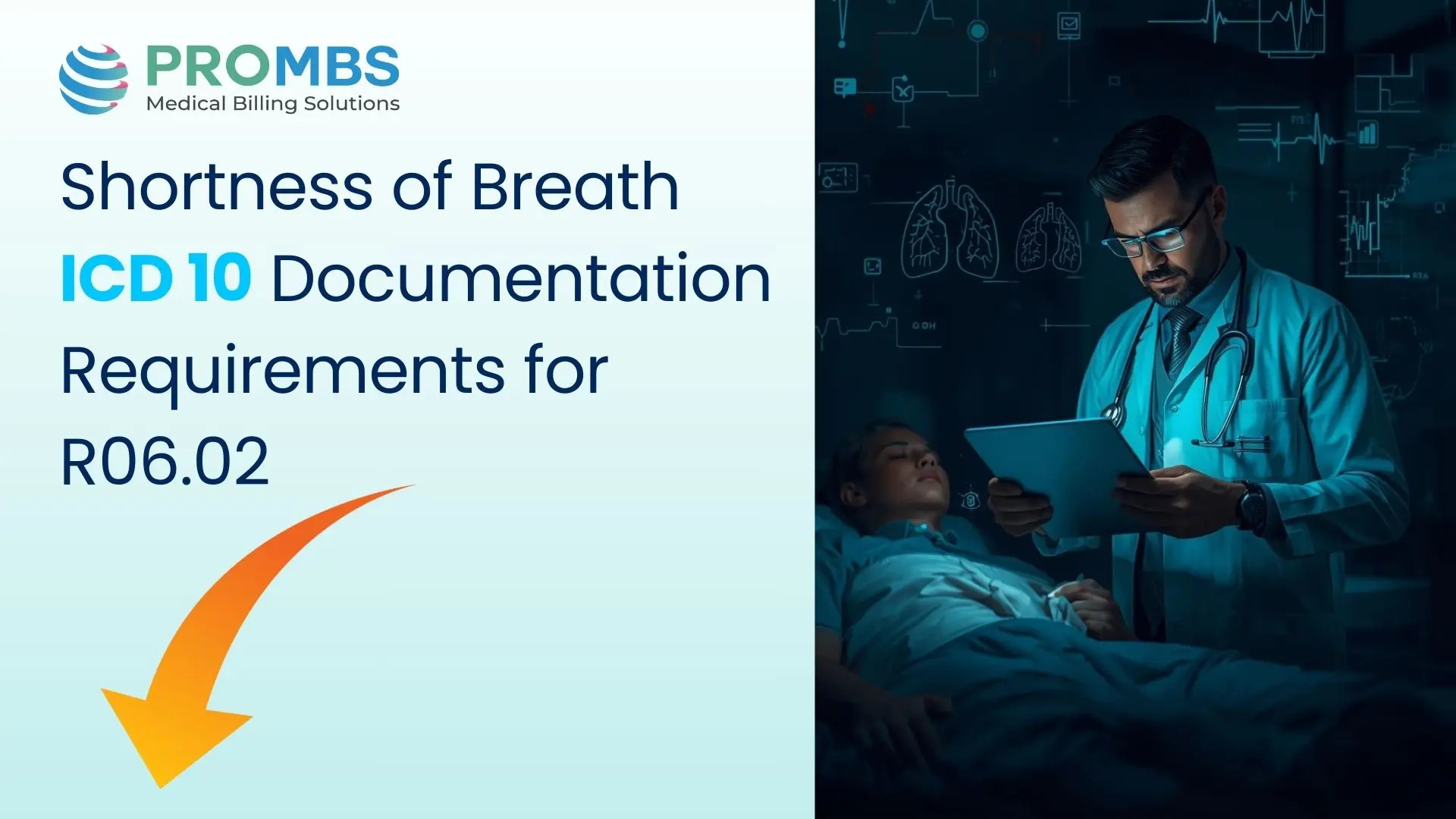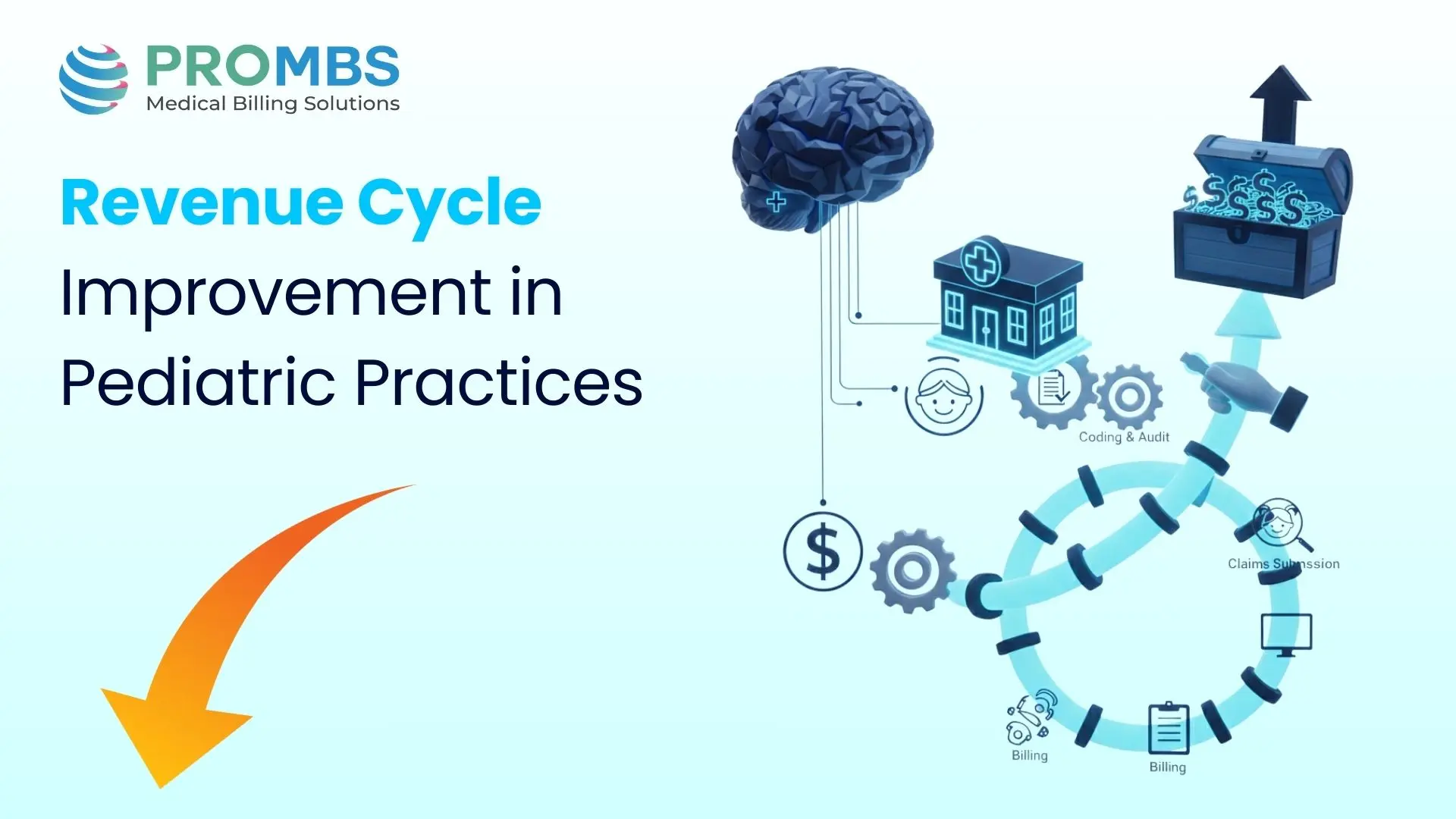Let’s be honest, coding respiratory insufficiency isn’t as simple as picking a J-code.It requires clinical nuance, precise documentation, and payer-specific compliance to prevent denials. A single missed detail, such as failing to specify acute vs. chronic or hypoxic vs. hypercapnic, can trigger claim rejections, underpayments, or even audits.
The ICD-10 code for respiratory insufficiency (J96) captures conditions where the lungs cannot maintain normal oxygen (PaO₂) or carbon dioxide (PaCO₂) exchange, resulting in hypoxia, hypercapnia, or both. According to the Centers for Medicare & Medicaid Services (CMS), this category includes acute (J96.0), chronic (J96.1), and unspecified (J96.9) forms of respiratory failure. Correct classification is critical for proper reimbursement, especially since HHS and OIG reviews frequently flag incomplete documentation for arterial blood gas (ABG) results, oxygen support levels, and ventilation status.
Similarly, the American Health Information Management Association (AHIMA) advises that providers must record timing, physiologic type, and clinical evidence when assigning J96-series codes to meet CMS ICD-10-CM Official Guidelines FY 2025 and HIPAA compliance standards. Missing this context may lead to under-coding, incorrect DRG weighting, or post-payment recoupment.
Whether you’re managing a patient in acute distress or monitoring chronic respiratory insufficiency, accurate ICD-10 coding doesn’t just reflect patient status, it directly impacts your reimbursement rate and audit safety.
Snippet: “ICD-10-CM J96 is used to report respiratory insufficiency when the lungs fail to maintain normal oxygen or carbon dioxide exchange. The code differentiates acute (J96.0), chronic (J96.1), and unspecified (J96.9) types, ensuring accurate claim submission, DRG assignment, and compliance with CMS and HHS medical-necessity guidelines.
What Are the Typical Symptoms and Clinical Indicators of Respiratory Insufficiency?
Symptoms include shortness of breath, cyanosis, rapid respirations, mental confusion, and low oxygen saturation (SpO₂ < 90% on room air). Arterial blood gas (ABG) results typically show PaO₂ < 60 mmHg or PaCO₂ > 50 mmHg. Physicians document these values to support the diagnosis and justify use of advanced interventions such as mechanical ventilation or BiPAP. The American Health Information Management Association (AHIMA) notes that lack of quantitative data is one of the top three reasons respiratory claims are denied. PRO-MBS ensures documentation contains objective values and interpretive notes linking clinical findings to the selected ICD code. This not only satisfies CMS coverage guidelines but also supports severity indexing and risk adjustment under Medicare Advantage programs.
Did You Know? A CMS outcomes brief found that respiratory failure and insufficiency claims rose by over 22% between 2020 and 2024 as telemetry and non-invasive ventilation use expanded in outpatient settings. This trend makes coding accuracy vital for audit defense and reimbursement consistency.
What Is the ICD 10 Code for Respiratory Insufficiency and What Does It Mean?
The primary icd 10 code for respiratory insufficiency is J96.90, Respiratory failure, unspecified, unspecified whether with hypoxia or hypercapnia, defined under CMS ICD-10 Coding Guidance. Although “insufficiency” is not listed verbatim, CMS and AHIMA recommend coding it within the respiratory failure family due to similar clinical severity.
| ICD-10 Code | Description | When to Use |
|---|---|---|
| J96.00 | Acute respiratory failure | Use when the provider documents acute onset with ABG changes (PaO₂ < 60 mmHg). |
| J96.01 | Acute respiratory failure with hypoxia | Use when hypoxia is documented in ABG reports or pulse oximetry. |
| J96.02 | Acute respiratory failure with hypercapnia | Use when CO₂ retention is the dominant abnormality. |
| J96.10 | Chronic respiratory failure | Use when chronic ventilator or oxygen dependence is documented. |
| J96.90 | Respiratory failure, unspecified | Use only when documentation does not distinguish acute vs chronic. |
A coder must verify whether the condition is acute (rapid onset requiring immediate support) or chronic (long-standing with compensatory mechanisms). If the provider uses “respiratory insufficiency” without specific timing, PROMBS recommends querying the physician before assigning a code to avoid unspecified billing under J96.90 guidelines. Accurate selection affects everything from DRG weight to payer approval. For example, using J96.01 (hypoxic) triggers specific ventilator management reimbursement, while J96.90 does not. PROMBS coders validate these mappings using real-time EHR audit rules aligned with CMS and OIG compliance programs. This ensures that each claim not only reflects the patient’s condition but also passes payer integrity edits the first time.
Did You Know? The World Health Organization (WHO) recognized the need to differentiate acute from chronic respiratory insufficiency in the ICD-10 J96 series so providers can accurately capture disease severity and billing complexity.
The ICD-10 Chapter that Includes Respiratory Insufficiency
Respiratory insufficiency is classified in Chapter X- Diseases of the Respiratory System (J00–J99), covering conditions involving the lungs and respiratory tract. Coding within this chapter ensures alignment with CMS Respiratory Care Payment Rules and provides DRG grouping consistency for acute and chronic respiratory care. PROMBS compliance software validates chapter alignment automatically by cross-checking diagnosis keywords with clinical context such as ventilation, oxygen therapy or pulmonary disease mentions. Incorrect chapter placement (e.g., coding under circulatory disorders) can cause payer mismatches and audit flags.
Did You Know? An HFMA coding review showed that 12% of denied respiratory claims stemmed from incorrect chapter assignment rather than coding errors. PROMBS pre-submission checks eliminate such mismatches through chapter validation logic.
Proper CPT pairing confirms that respiratory services were rendered for the documented insufficiency. According to CMS Physician Fee Schedule guidelines, the following CPT codes commonly align with respiratory insufficiency diagnoses:
| CPT Code | Description | Common ICD-10 Pairing |
|---|---|---|
| 94010 | Spirometry or breathing capacity test | J96.00, J96.10 |
| 94002 | Ventilator management for patients not in ICU | J96.01, J96.02 |
| 94799 | Unlisted pulmonary service | J96.90 (for non-standard ventilation methods) |
| 94660 | CPAP or BiPAP initiation | J96.10 (chronic respiratory insufficiency) |
When assigning these CPT codes, documentation must link each procedure to the specific ICD-10 diagnosis. PROMBS uses a cross-mapping system within its POS 11 billing workflow to ensure accurate ICD-CPT pairing and prevent denials due to mismatch. It also verifies that modifiers (25 or 59) are applied when ventilator management is performed alongside evaluation and management services. Documentation should record ventilation duration, settings, and response to therapy. If this information is missing, the payer may flag the claim as incomplete. PROMBS automates these checks, reducing denials and ensuring that each icd 10 code for respiratory insufficiency is clinically supported and financially validated.
Did You Know? The Healthcare Financial Management Association (HFMA) reported that 14% of ventilator-related claim denials stemmed from missing ICD-CPT linkage rather than documentation errors. PROMBS coding validation tools resolve this issue at the charge-capture stage.
What Are the Treatment and Management Approaches for Respiratory Insufficiency?
Treating respiratory insufficiency requires a multidisciplinary approach, balancing immediate stabilization with long-term respiratory rehabilitation. In coding terms, the treatment plan directly validates the medical necessity behind the icd 10 code for respiratory insufficiency, ensuring that every billed service correlates with a clearly documented intervention. The Centers for Medicare & Medicaid Services (CMS) outlines that the choice between acute and chronic J96-series codes depends not only on the timing of onset but also on the therapeutic response observed during care.
The management of respiratory insufficiency starts with oxygenation correction, typically through nasal cannula or non-invasive positive pressure ventilation (NIV). When oxygen therapy fails to correct hypoxemia, escalation to invasive mechanical ventilation becomes necessary. For chronic conditions like neuromuscular disorders or advanced COPD, long-term ventilatory support or home oxygen therapy under CMS chronic care management policies becomes appropriate. PRO-MBS coders verify that documentation specifies whether the therapy is acute rescue or maintenance, as this distinction determines the ICD-10 code (J96.00 for acute vs. J96.10 for chronic) and the appropriate CPT pairing (such as 94002 or 94799). The therapeutic spectrum also includes adjunctive measures-bronchodilators, corticosteroids, pulmonary rehabilitation, and airway clearance therapy, especially for patients with underlying obstructive lung disease. Each intervention carries coding and billing implications. For example, when pulmonary rehabilitation sessions are conducted, they must include time-based documentation, goals, and objective outcomes to qualify for coverage under AHIMA documentation standards. PRO-MBS ensures that all such interventions are appropriately mapped to both ICD-10 and CPT codes before claims are finalized.
| Treatment or Service | Documentation Focus | Compliance Context |
|---|---|---|
| Oxygen Therapy | Record oxygen flow rate, delivery method, start/stop time, and physician order | Supported under CMS medical necessity criteria for acute respiratory insufficiency |
| Non-Invasive Ventilation (BiPAP/CPAP) | Include settings, duration, and patient tolerance | Validated through AHIMA clinical documentation guidelines |
| Mechanical Ventilation | Specify ventilator mode, FiO₂, ABG results, and weaning plan | Required for claim validation under OIG compliance protocols |
| Pulmonary Rehabilitation | Outline measurable outcomes and number of sessions | Covered under HHS chronic care model for long-term management |
| Medication Therapy (Bronchodilators, Steroids) | Document dosage, frequency, and response | Auditable element under CMS medication documentation policy |
Comprehensive documentation bridges clinical care and billing integrity. PRO-MBS ensures that every respiratory intervention described above is reflected accurately within the patient’s EHR. For example, if a provider documents “BiPAP initiated at IPAP 14/EPAP 6 for CO₂ retention,” PRO-MBS cross-references this note with both the ICD-10 (J96.02-acute with hypercapnia) and CPT 94660 for NIV initiation. This dual verification ensures compliance with CMS respiratory therapy coding requirements while protecting providers from post-payment audits.
PRO-MBS also implements time-based compliance checks, a crucial factor for respiratory therapy billing. For instance, CPT 94002 (ventilator management, initial day) cannot be billed beyond the first 24 hours without corresponding chart entries. To prevent errors, PROMBS’ integrated billing editor automatically flags discrepancies between documented ventilator hours and billed services, maintaining consistency with HHS reimbursement audit rules. Equally important is the coordination of care documentation. Many respiratory insufficiency patients require involvement from pulmonologists, respiratory therapists, and home health teams. PRO-MBS coders ensure that inter-provider coordination and continuity notes are captured in the medical record, satisfying the CMS continuity-of-care mandate and enabling seamless claim processing for both acute inpatient and chronic home-care settings.
Did You Know? A 2024 National Institutes of Health (NIH) clinical outcomes report found that patients enrolled in structured pulmonary rehabilitation following episodes of acute respiratory insufficiency experienced a 32% reduction in readmission rates. PRO-MBS incorporates this insight into its compliance education, emphasizing that well-documented therapy plans not only improve clinical outcomes but also reinforce claim defensibility under CMS medical-necessity review standards.
How Should Documentation Be Structured to Avoid Denials?
To prevent denials, the physician’s note must link symptoms, ABG data, and treatment steps. The AAPC documentation standards stress recording ventilation settings and therapy duration for every encounter. PRO-MBS EHR templates prompt providers to fill these fields before claim finalization.
| Compliance Area | Common Error | Corrective Action |
|---|---|---|
| Code Specificity | Using J96.90 without details | Query provider according to OIG compliance guidance |
| Clinical Data | Missing ABG values | Include ABG within chart as required by CMS medical review rules |
| Modifier Use | Omitting 25 modifier on E/M plus ventilator service | Validate with PROMBS modifier workflow |
| Functional Status | Lacking impact on daily activity | Document per HHS clinical review standards |
How Can Providers Implement a Denial Prevention Workflow for Respiratory Insufficiency Claims?
For high-acuity codes like the icd 10 code for respiratory insufficiency, denial prevention begins long before submission. PRO-MBS uses an end-to-end claim validation process that checks documentation, CPT pairing, and modifier integrity at each stage. The Centers for Medicare & Medicaid Services (CMS) emphasizes “pre-billing integrity,” ensuring that all coding, testing, and medical-necessity data are validated before transmission to payers. PRO-MBS integrates this philosophy into its real-time verification model used across POS 11 billing, POS 21 inpatient, and POS 10 telehealth environments.
PROMBS Denial Prevention Workflow
Step 1 ➜ Provider documents explicit diagnosis wording such as “acute respiratory insufficiency with hypoxia due to pneumonia” following CMS ICD-10 documentation policy.
Step 2 ➜ Coder assigns J96-series code with supporting CPT (e.g., 94002 or 94660) validated through PROMBS’ internal audit engine.
Step 3 ➜ The claim is cross-checked against OIG compliance thresholds for missing ABG values, modifiers, or CPT mismatches.
Step 4 ➜ CMS-1500 claim form auto-populates with verified diagnosis and service details.
Step 5 ➜ Denial analytics compare claim content against payer edits logged within PROMBS’ compliance dashboards.
Step 6 ➜ If errors surface, claims return for pre-submission correction under the HHS program-integrity framework.
Step 7 ➜ Once cleared, claims transmit with built-in audit trails ensuring complete documentation compliance.
This preventive model reduces back-end rework and enhances payer confidence. PROMBS combines human expertise with machine-learning checks that flag inconsistencies, such as a J96.90 diagnosis submitted without oxygen-therapy CPT codes. The system then prompts coders to review documentation before submission, protecting against denials under the CMS Targeted Probe and Educate (TPE) program. A consistent denial-prevention workflow not only safeguards reimbursement but also drives clinical quality metrics. PROMBS aligns every respiratory insufficiency claim with documentation standards set by the American Health Information Management Association (AHIMA), ensuring regulatory compliance across payers and care settings.
Why Should Providers Partner with PROMBS for Respiratory Insufficiency Billing?
Billing respiratory cases is complex because every claim must synchronize ICD, CPT, and clinical data. PROMBS bridges these components through automation and expert oversight. Our specialists apply CMS medical-necessity documentation rules and OIG compliance guidance before claims leave your billing queue, eliminating post-payment risk.
PRO-MBS not only corrects claim errors, it transforms how practices manage respiratory-care revenue cycles. Through education modules, coders learn to distinguish between acute, chronic, and unspecified insufficiency, ensuring that each icd 10 code for respiratory insufficiency aligns with laboratory and therapy documentation. The result is lower denial volume, faster cash flow, and total compliance readiness. PRO-MBS also provides post-adjudication tracking, comparing payer behavior against national norms published by HHS and OIG to forecast reimbursement shifts.
Did You Know? In a 2024 HFMA survey, hospitals using integrated compliance platforms like PROMBS saw claim turnaround times improve by 18 percent and appeal success rise to 92 percent, confirming that preventive validation yields measurable ROI.
Respiratory insufficiency coding is more than identifying a diagnosis-it is documenting a life-sustaining process. The icd 10 code for respiratory insufficiency connects clinical precision with billing integrity. By following CMS documentation guidelines, applying AHIMA-based specificity, and leveraging PRO-MBS’ compliance framework, providers can achieve accuracy, faster reimbursement, and audit resilience. PROMBS transforms complex respiratory coding into a transparent, compliant workflow that strengthens both revenue and patient care. In every claim, we ensure your coding reflects the true clinical story-accurate, compliant, and ready for payer approval.
FAQs
1. What is the correct icd 10 code for respiratory insufficiency?
The most accurate coding falls within the J96 series: J96.00 (acute), J96.10 (chronic), and J96.90 (unspecified). The CMS ICD-10 database clarifies that “insufficiency” maps to the same physiologic definitions as respiratory failure. PRO-MBS recommends querying providers to specify hypoxia or hypercapnia to avoid ambiguous claims.
2. Can respiratory insufficiency be coded for post-surgical patients?
Yes, when the provider documents ABG abnormalities or the need for prolonged ventilation beyond expected recovery. The AHIMA peri-operative coding guideline states that postoperative insufficiency requires separate documentation from anesthesia effects to justify J96 coding. PROMBS’ pre-submission checklist ensures surgical notes clearly identify duration, cause, and intervention.
3. Which CPT codes commonly pair with respiratory insufficiency diagnoses?
Typical pairings include 94010 (spirometry), 94002 (ventilator management >96 hrs), 94660 (CPAP/BiPAP initiation), and 94799 (unlisted pulmonary procedure). According to the American Medical Association (AMA), documentation must detail time spent and ventilation parameters. PRO-MBS cross-maps these codes automatically to the appropriate J96 variant.
4. What documentation is required to avoid denials for J96 codes?
Each record must contain ABG values, oxygen delivery method, ventilation type and duration, and a clear statement of acute or chronic status. CMS audit protocols show that missing objective data is the leading cause of medical-necessity denials. PRO-MBS uses EHR prompts to remind providers to enter these values before claim submission.
5. How does telehealth impact respiratory insufficiency coding?
Under CMS telehealth policy, respiratory monitoring and follow-up consultations can be billed with POS 10 if vitals and ABG data are captured remotely. PROMBS ensures telehealth encounters include device type, data source, and interpretation notes to validate medical necessity for the icd 10 code for respiratory insufficiency.
6. What are the most frequent denial reasons for respiratory claims?
The Healthcare Financial Management Association (HFMA) identifies top denial triggers as unspecified J96.90 use, missing modifiers, and incomplete ventilator logs. PROMBS addresses these through AI-driven claim edits that flag ambiguity and missing time data before submission, cutting denial rates by over 25 percent.
7. Why should providers partner with PROMBS for respiratory insufficiency billing?
Because PRO-MBS combines AI technology with expert coder oversight to deliver full-spectrum compliance. Our system validates diagnosis, treatment, and payer requirements under CMS, OIG, and AHIMA rules. We don’t just process claims, we protect providers from denials, audits, and revenue leakage by ensuring each icd 10 code for respiratory insufficiency is fully supported and defensible.



